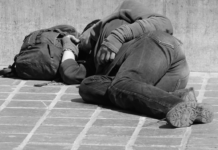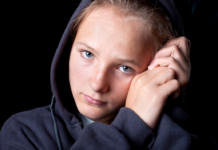#1. In 2015, 37% of the people who experienced homelessness at some point during the year were families who had children. (Sasaki)
#2. 6% of the total homelessness population are children, experiencing a range of homelessness severity. Some have moved more than twice within the past 60 days. Others have been forced to live out in the streets. (Sasaki)
#3. In 2017, there were over 553,000 people identified in the United States who were experiencing homelessness. That equates to a rate of about 17 people for every 10,000. That is the lowest rate of calculated homelessness since this information has been obtained. (National Alliance to End Homelessness)
#4. From 2016 to 2017, the number of people experiencing homelessness increased by 0.7%. The group that experienced the largest increase was young adults and unaccompanied children, with a 14.3% increase. There was also a 12.2% increase in the number of people experiencing chronic homelessness. (National Alliance to End Homelessness)
#5. The number of families who experienced homelessness fell by 5.2% from 2016 to 2017. (National Alliance to End Homelessness)
#6. Most of the homeless population in the United States lives in transitional housing or some form of shelter. About 360,000 people take refuge in these locations each night. 34% of the homeless population, however, uses an alternative location, such as an abandoned building, a public park, or a street. (National Alliance to End Homelessness)
#7. More than 7% of the homeless population in the United States are military veterans, which equates to more than 40,000 people without a regular home who once served the country in some way. (National Alliance to End Homelessness)
#8. 60% of the states in the U.S. reported a decrease in overall homelessness in 2017. The State of Georgia reported the largest decrease, with over 2,700 fewer people experiencing this challenge. California saw the largest increase in homelessness, with more than 16,000 people not having a regular home. (National Alliance to End Homelessness)
#9. 52.8% of the beds that are available to those who are homeless in the United States are part of permanent housing intervention programs. Emergency shelters account for about one in three available beds for the homeless across the country. (National Alliance to End Homelessness)
#10. Rapid re-housing is a new alternative being explored in the United States, with the first programs reporting data in 2013. In 2017, it accounts for 10% of the beds that are available. These programs have grown by 372% since they were first started. (National Alliance to End Homelessness)
#11. Since 2007, 49 states have reported a higher permanent supportive housing capacity. The only state that does not have a higher capacity is Arkansas. California saw the highest increases, with over 33,000 new beds. New York had the second-highest capacity increase, with 11,300 beds, while Texas reported a 9,500 increase in bed count. (National Alliance to End Homelessness)
#12. About 1 in 4 people who are homeless in the United States suffer from some form of a severe mental illness. That is compared to just 6% of the general population of the country. (National Coalition for the Homeless)
#13. The mayors of 25 cities in the U.S. were asked to list the 3 largest causes of homelessness in their communities. For single adults, 48% of the mayors stated that mental illness was an issue. Even in homeless families, 12% cited mental illness as a primary challenge. (National Coalition for the Homeless)
#14. 15% of the people who were diagnosed with bipolar disorder or schizophrenia were homeless at least once in a 12-month period in California. (National Coalition for the Homeless)
#15. 505 of the homeless population that has a mental illness or could be diagnosed with one is also suffering from a substance abuse and dependency issue. African-Americans are over-represented in this group, often using street drugs to self-medicate themselves. (National Coalition for the Homeless)
#16. 8% of people who are homeless and have had a previous psychiatric hospitalization obtain food from garbage cans as their primary source of nourishment. 28% of people who meet this description obtained some food from a garbage can over the past month. (Mental Illness Policy Org)
#17. About 90,000 people in the United States suffer from chronic patterns of homelessness throughout any given year. (Substance Abuse and Mental Health Services Administration [SAMHSA])
#18. Up to 2 million young adults in the United States experience homelessness at least once over the course of a year. A survey of homeless youth service providers in the U.S. indicates that up to 40% of the youth who are homeless identify as being part of the LGBTQIA+ community. (SAMHSA)
#19. In 35 states, the number of renter households classified as poor and experiencing a severe housing cost burden decreased. To meet this definition, the household must pay 50% or more of their income on housing. The largest decrease was experience in Maine, which saw a 20.7% drop in this issue. (National Alliance to End Homelessness)
#20. In 2016, over 4.6 million people living in poor households had doubled up with either family or friends. Although this figure is 5.7% lower than it was in 2015, the number of people in this situation has risen by 30% since 2007. (National Alliance to End Homelessness)
#21. Montana saw the largest decrease in the number of people doubling up, with this issue declining by 56% in 2016. In North Dakota, the story was much different, with a 180% increase in the number of people doubling up. (National Alliance to End Homelessness)
#22. Only 3 states saw a decrease in doubling up households, with Colorado and New Hampshire joining Montana. (National Alliance to End Homelessness)
#23. About 100 million people are believed to be homeless around the world. Up to 1.6 billion people may lack adequate housing. (Habitat for Humanity)
#24. 20% of the homeless population living in the United States were either living in New York City or Los Angeles. In total, 49% of the homeless population is located in a major city in the United States. (Huffington Post)
#25. The percentage of approved families for entering a shelter decreased from 50% to 42% in 2016. The number of families forced to apply for a shelter 2+ times before being determined to be eligible increased from 37% to 45% over the same year. (Huffington Post)
#26. 89% of homeless unaccompanied youth are most likely to be between the ages of 18 to 24. The remaining 11% of this population is under the age of 18. That means about 3,700 of the current homeless population in the U.S. are actual children. (Huffington Post)
#27. 14% of community college students in the United States reported that they were homeless while enrolled in classes. For former foster youth, the rate of homelessness is much higher in this situation, at 29%. (Huffington Post)
#28. 51% of college students who report that they are homeless are balancing work and school simultaneously. Over half of the students who are employed and homeless were working between 20 to 40 hours each week, with almost everyone earning less than $15 per hour for their services. (Huffington Post)
#29. In 2016, about 1 in 1,670 people in the United States experienced homelessness of some type at least once during the year. On any given night, 0.06% of the population will look to a shelter, a housing program, or a tent on the street as a way to spend the night. (Our World in Data)
#30. Since 2007, the overall homeless population in the United States has been experiencing a downward trend. There are almost 100,000 fewer people who are homeless in the U.S. today than there were back then. (Our World in Data)
#31. In the United Kingdom, the number of unsheltered homeless individuals has been steadily rising since 2010. In 2016, there were 4,134 people counted as being unsheltered and homeless, compared to just 1,768 in 2010. (Our World in Data)
#32. The rate of unsheltered homeless people per 100,000 in population has also doubled in the UK since 2010, reaching 6.51 in 2015. (Our World in Data)
#33. The estimated number of homeless individuals, per 100,000 people, in total population is led globally by France, with a ratio of 216.77. The United States comes in second, with a ratio of 177.1. These two countries are followed by Chile (155.72), Ireland (78.32), Spain (49.38), and Portugal (20.19). (Our World in Data)
#34. In the UK, about 1 in every 13 adults reports that they have slept at least once in a shelter or on the streets during their lifetime. (Our World in Data)
#35. As a share of the population who reports that they have been homeless at least once in their lives, the United Kingdom leads the world at 7.7%. The United States is second, at 6.2%. These countries are followed by Italy (4%), Belgium (3.4%), and Germany (2.4%). (Our World in Data)
#36. Around 1.4 million veterans in the U.S. are believed to be at-risk of experiencing homelessness in the next year. Those who served in Vietnam are at the greatest risk of homelessness in this population, followed by those with physical disorders, PTSD, or a traumatic brain injury. (National Alliance to End Homelessness)
#37. About 10% of U.S. veterans who are homeless are women. 45% of homeless veterans are either African-American/Black or Hispanic. Although the total number of homeless veterans has decreased by 35% since 2009, several cities, like Washington, DC have still seen increases. (National Alliance to End Homelessness)
#38. 50% of the current homeless population in the United States is above the age of 50. In this age demographic, there are vulnerabilities to falls, vision loss, hearing loss, and cognitive impairment. (National Alliance to End Homelessness)
#39. In 2014, homelessness in Cameroon rose because of internal ethnic conflicts. About 5,000 people entered the homeless population because of this issue, joining another 25,000 people who were affected by natural disasters and floods. (Homeless World Cup Foundation)
#40. More than 15 million people live in slum areas of Egypt, with or without a permanent home. About 40% of this population lives in and around Cairo. (Homeless World Cup Foundation)
#41. 51% of the urban residents in Ghana live in slum areas. 70% of those who meet the definition of homeless in the country are under the age of 20. (Homeless World Cup Foundation)
#42. In Kenya, there are at least 250,000 people in Nairobi who do not have a permanent home. Up to 300,000 children may be living or working on the streets in Kenya. (IRIN News)
#43. About 105,000 people are believed to be homeless in Australia. 44% of this population are women, with 12% being children under the age of 12. (Homeless World Cup Foundation)
#44. About 1 in 4 people who are homeless in Australia are either Torres Strait Islanders or Aboriginal. 30% of those who are homeless in Australia were actually born in a different country. (Homelessness Australia)
#45. There are around 25,000 people who are currently homeless in Japan. About 20% of the homeless population who live in Tokyo. (International Network of Street Papers)
#46. The issue with the homeless counts in Tokyo is that people who move from café to café during the overnight hours are not counted as being homeless. Up to 3 million people without a home spend their nights in internet café locations. (Homeless World Cup Foundation)
#47. More than 78 million people in India may be homeless. There are an estimated 11 million children who are currently living in the streets. About 30% of the homeless population comes from a rural area of the country. (Homeless World Cup Foundation)
#48. 40% of the population in Hong Kong lives in subsidized housing, with 100,000 people living in cages on the rooftops of home. It is these tiny “homes” which keep the homeless population of the city down to about 1,400 people each year. (The Global Mail)
#49. In South Korea, there were about 5,000 people classified as homeless in 2012 official data. That figure has risen by 900 people in just 2 years. That number does not include about 6,000 residents who ae believed to reside in rental hostels on a regular basis. (Korean Herald)
#50. More than 200 million people live in Pakistan, with 10% of the population lacking access to housing within the country. Up to 40% of people in the country are classified as living in conditions which qualify as “multi-dimensional poverty.” (Homeless World Cup Foundation)
#51. Over 25% of the population in The Philippines lives below the national poverty line. The United Nations believes that over 40% of the population lives in qualifying slum areas. (Homeless World Cup Foundation)
#52. The city of Manila in The Philippines has what is believed to be the largest homeless population of any other city in the world. Over 3 million people are homeless in Manilla, with 70,000 of that population being children. (Homeless World Cup Foundation)
#53. In Brussels, Belgium, about 3,200 people accessed homeless accommodations in 2010. Another 8,600 people were staying in hostels or using supporting housing. About 5,000 people were considered to be homeless in Wallonia. (FEANTSA)
#54. There are an estimated 143,000 people living in homelessness in Bosnia. The government doesn’t track homelessness there, however, so no official records exist to determine the overall threat of this complex issue. (SOS Djecija Sela)
#55. More than 284,000 people in Germany reported that they had nowhere to live in 2012. That was a 15% increase over the figures released in 2010. Around 15% of those who applied for homelessness assistance programs in Germany were not born in the country. (Homeless World Cup Foundation)
#56. More than 3.4 million people are at-risk of living in poverty or social exclusion in Greece. Despite this high risk, the total number of people struggling with homelessness in the country is around 20,000. (Reuters)
#57. In France, over 103,000 adults sought out food relief from soup kitchens in an urban area. About 30% of this population dealing with hunger were children. Since 2001, the number of people who are homeless has risen in France by almost a 50% margin. (Homeless World Cup Foundation)
#58. More than 35,000 people in Canada struggle with homelessness on any given night. Over the course of a year, over 235,000 people in the country will have needed to access a homelessness resource at least once. (Homeless Hub)
#59. Up to 33,000 people in Canada may be affected by chronic homelessness over the course of a year. Most will stay in an emergency shelter or a provisional accommodation. Only 5,000 people are believed to be unsheltered in Canada. (Homeless World Cup Foundation)
#60. In Grenada, 90% of the homes were affected by a hurricane in 2004. That left over 60,000 people without a home, which was more than half of the island’s population. Many households are still struggling to recover from this incident. (Red Cross)
#61. 475,000 people are believed to be without a home in the nation of Guatemala. That includes 8,000 children who are believed to be at-risk of being recruited by a street gang before they reach the age of 18. (Homeless World Cup Foundation)
#62. In Mexico City, about half of the population lives in a low-income, informal settlement. Up to 30,000 people may be living on the streets of the city at any given time. (Homeless World Cup Foundation)
#63. More than 12,000 people are believed to be homeless in the country of Chile, with almost half of the population living in Santiago. (The Santiago Times)
#64. In Colombia, over 3.8 million households lack access to an adequate home. Almost 6 million people have been displaced because of conflict. That means 5% of the population, over 662,000 families, are currently homeless. (Colombia Ministry of Housing)
#65. Only 41% of adults in the U.S. with a mental health condition received any type of health service in the past year. For those with a serious mental illness, 37% did not receive any mental health services within the past year. That’s despite the fact that 1 in 4 homeless adults staying or living in a shelter have a serious mental illness. (National Alliance on Mental Health)
#66. Serious mental illness costs almost $200 billion in lost earnings every year, and over 9)% of children who commit suicide in the country have a mental health issue. (National Alliance on Mental Health)
#67. Up to 22 veterans in the United States die each day by suicide. (National Alliance on Mental Health)
Homelessness is an issue that hopefully no one must face in the future. There are some who may still choose to be homeless because they prefer the vagabond type of lifestyle. What we must do is work toward eliminating involuntary homelessness from the equation.
Each year, over 2 million youth in the United States will experience homelessness or be threatened by it. For our youth especially, the primary cause of homelessness is emotional, physical, or sexual abuse by their parents or guardians.
For adults, mental illness and substance abuse are contributing factors to the homelessness issue that the world faces.
Between these two causes, we can see that the majority of homelessness is preventable. Because that is so, we must continue working to identify homelessness triggers, identify those most at-risk of experiencing this issue, and then work together to eliminate its root cause, once and for all.














